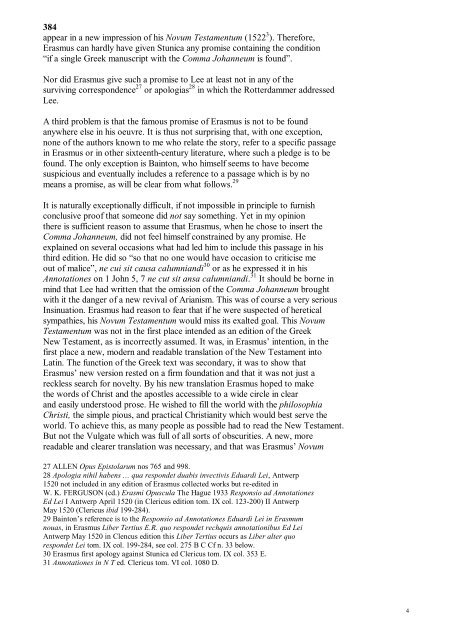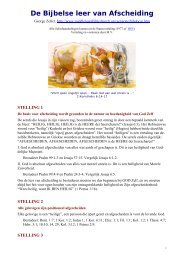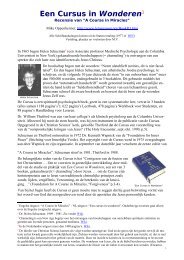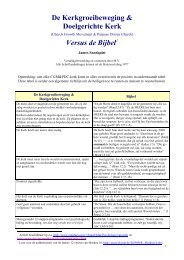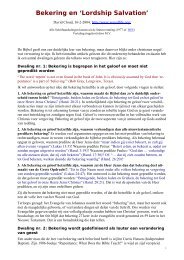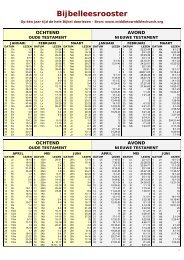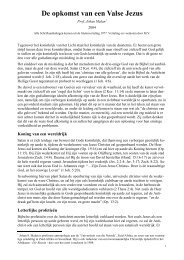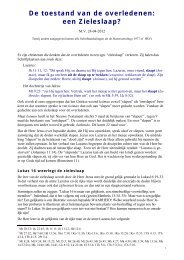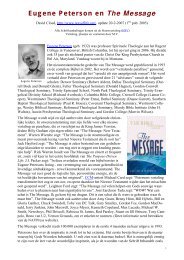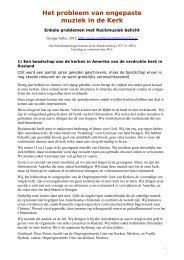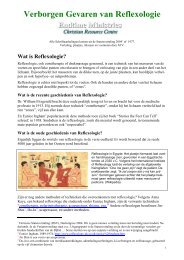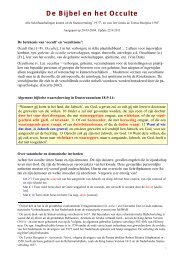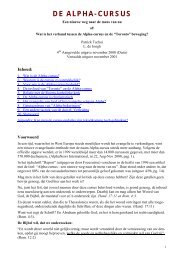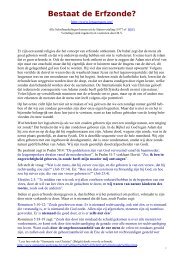erasmus and the comma johanneum - Marc Verhoeven
erasmus and the comma johanneum - Marc Verhoeven
erasmus and the comma johanneum - Marc Verhoeven
You also want an ePaper? Increase the reach of your titles
YUMPU automatically turns print PDFs into web optimized ePapers that Google loves.
384<br />
appear in a new impression of his Novum Testamentum (1522 3 ). Therefore,<br />
Erasmus can hardly have given Stunica any promise containing <strong>the</strong> condition<br />
“if a single Greek manuscript with <strong>the</strong> Comma Johanneum is found”.<br />
Nor did Erasmus give such a promise to Lee at least not in any of <strong>the</strong><br />
surviving correspondence 27 or apologias 28 in which <strong>the</strong> Rotterdammer addressed<br />
Lee.<br />
A third problem is that <strong>the</strong> famous promise of Erasmus is not to be found<br />
anywhere else in his oeuvre. It is thus not surprising that, with one exception,<br />
none of <strong>the</strong> authors known to me who relate <strong>the</strong> story, refer to a specific passage<br />
in Erasmus or in o<strong>the</strong>r sixteenth-century literature, where such a pledge is to be<br />
found. The only exception is Bainton, who himself seems to have become<br />
suspicious <strong>and</strong> eventually includes a reference to a passage which is by no<br />
means a promise, as will be clear from what follows. 29<br />
It is naturally exceptionally difficult, if not impossible in principle to furnish<br />
conclusive proof that someone did not say something. Yet in my opinion<br />
<strong>the</strong>re is sufficient reason to assume that Erasmus, when he chose to insert <strong>the</strong><br />
Comma Johanneum, did not feel himself constrained by any promise. He<br />
explained on several occasions what had led him to include this passage in his<br />
third edition. He did so “so that no one would have occasion to criticise me<br />
out of malice”, ne cui sit causa calumni<strong>and</strong>i 30 or as he expressed it in his<br />
Annotationes on 1 John 5, 7 ne cut sit ansa calumni<strong>and</strong>i. 31 It should be borne in<br />
mind that Lee had written that <strong>the</strong> omission of <strong>the</strong> Comma Johanneum brought<br />
with it <strong>the</strong> danger of a new revival of Arianism. This was of course a very serious<br />
Insinuation. Erasmus had reason to fear that if he were suspected of heretical<br />
sympathies, his Novum Testamentum would miss its exalted goal. This Novum<br />
Testamentum was not in <strong>the</strong> first place intended as an edition of <strong>the</strong> Greek<br />
New Testament, as is incorrectly assumed. It was, in Erasmus’ intention, in <strong>the</strong><br />
first place a new, modern <strong>and</strong> readable translation of <strong>the</strong> New Testament into<br />
Latin. The function of <strong>the</strong> Greek text was secondary, it was to show that<br />
Erasmus’ new version rested on a firm foundation <strong>and</strong> that it was not just a<br />
reckless search for novelty. By his new translation Erasmus hoped to make<br />
<strong>the</strong> words of Christ <strong>and</strong> <strong>the</strong> apostles accessible to a wide circle in clear<br />
<strong>and</strong> easily understood prose. He wished to fill <strong>the</strong> world with <strong>the</strong> philosophia<br />
Christi, <strong>the</strong> simple pious, <strong>and</strong> practical Christianity which would best serve <strong>the</strong><br />
world. To achieve this, as many people as possible had to read <strong>the</strong> New Testament.<br />
But not <strong>the</strong> Vulgate which was full of all sorts of obscurities. A new, more<br />
readable <strong>and</strong> clearer translation was necessary, <strong>and</strong> that was Erasmus’ Novum<br />
27 ALLEN Opus Epistolarum nos 765 <strong>and</strong> 998.<br />
28 Apologia nihil habens … qua respondet duabis invectivis Eduardi Lei, Antwerp<br />
1520 not included in any edition of Erasmus collected works but re-edited in<br />
W. K. FERGUSON (cd.) Erasmi Opuscula The Hague 1933 Responsio ad Annotationes<br />
Ed Lei I Antwerp April 1520 (in Clericus edition tom. IX col. 123-200) II Antwerp<br />
May 1520 (Clericus ibid 199-284).<br />
29 Bainton’s reference is to <strong>the</strong> Responsio ad Annotationes Eduardi Lei in Erasmum<br />
nouas, in Erasmus Liber Tertius E.R. quo respondet rechquis annotationibus Ed Lei<br />
Antwerp May 1520 in Clencus edition this Liber Tertius occurs as Liber alter quo<br />
respondet Lei tom. IX col. 199-284, see col. 275 B C Cf n. 33 below.<br />
30 Erasmus first apology against Stunica ed Clericus tom. IX col. 353 E.<br />
31 Annotationes in N T ed. Clericus tom. VI col. 1080 D.<br />
4


